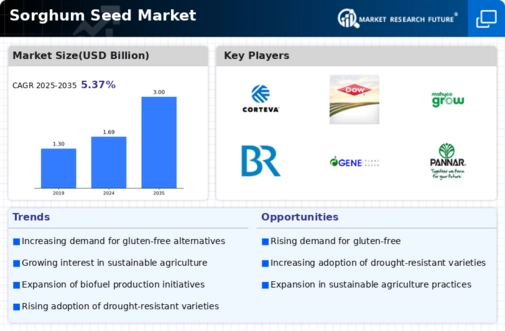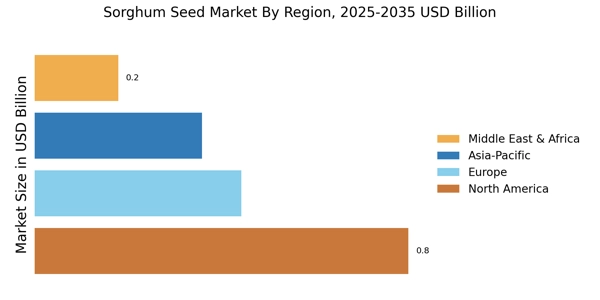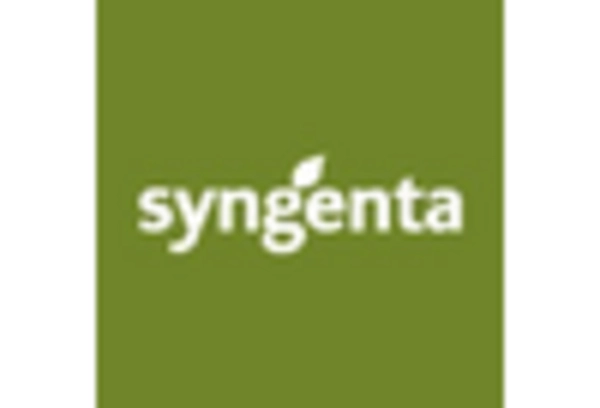Growing Interest in Biofuel Production
The rising interest in renewable energy sources is driving the Sorghum Seed Market, particularly in the context of biofuel production. Sorghum is recognized for its high biomass yield and ability to thrive in arid conditions, making it a viable candidate for biofuel feedstock. Recent estimates suggest that sorghum could contribute significantly to bioethanol production, with projections indicating a potential increase in sorghum-based biofuels by 25% over the next decade. This trend is further supported by government policies promoting renewable energy and reducing carbon emissions. As the demand for sustainable energy solutions continues to grow, the Sorghum Seed Market is likely to experience increased investment and interest from both agricultural and energy sectors.
Nutritional Benefits and Health Trends
The nutritional profile of sorghum is becoming increasingly recognized, contributing to its rising popularity in the Sorghum Seed Market. Rich in fiber, vitamins, and minerals, sorghum is being promoted as a superfood, appealing to health-conscious consumers. Recent surveys indicate that nearly 60% of consumers are actively seeking out whole grains, with sorghum being a preferred choice due to its health benefits. This trend is further amplified by the growing awareness of the importance of dietary diversity and the role of whole grains in preventing chronic diseases. As more food products featuring sorghum enter the market, the Sorghum Seed Market is expected to expand, driven by consumer demand for nutritious and health-oriented food options.
Rising Demand for Gluten-Free Products
The increasing consumer preference for gluten-free diets has led to a notable rise in the demand for sorghum seeds. Sorghum, being naturally gluten-free, is gaining traction among health-conscious consumers and those with gluten sensitivities. This trend is reflected in the Sorghum Seed Market, where the demand for gluten-free products is projected to grow at a compound annual growth rate of approximately 8% over the next five years. As more food manufacturers incorporate sorghum into their product lines, the market for sorghum seeds is likely to expand, driven by the need for alternative grains that cater to dietary restrictions. This shift not only enhances the visibility of sorghum but also positions it as a staple in health-oriented food products, thereby bolstering the overall growth of the Sorghum Seed Market.
Technological Innovations in Seed Breeding
Advancements in seed technology are playing a crucial role in shaping the Sorghum Seed Market. Innovations such as genetic modification and marker-assisted selection are enabling the development of sorghum varieties that are more resilient to pests and diseases. These technological improvements are expected to enhance yield potential and reduce the reliance on chemical inputs. Recent studies indicate that the introduction of these improved varieties could lead to yield increases of up to 20% in certain regions. As farmers seek to maximize productivity while minimizing environmental impact, the adoption of these advanced sorghum seeds is likely to accelerate. Consequently, the Sorghum Seed Market stands to gain from the ongoing research and development efforts aimed at enhancing seed performance and sustainability.
Increased Adoption of Sustainable Farming Practices
The growing emphasis on sustainable agriculture is significantly influencing the Sorghum Seed Market. Farmers are increasingly adopting practices that promote environmental stewardship, such as crop rotation and reduced chemical usage. Sorghum, known for its drought resistance and low input requirements, aligns well with these sustainable practices. According to recent data, the acreage dedicated to sorghum cultivation has increased by approximately 15% in regions prioritizing sustainable farming. This trend not only supports soil health but also enhances biodiversity, making sorghum an attractive option for farmers looking to improve their sustainability credentials. As the demand for sustainably sourced products rises, the Sorghum Seed Market is poised to benefit from this shift towards eco-friendly agricultural practices.


















Leave a Comment